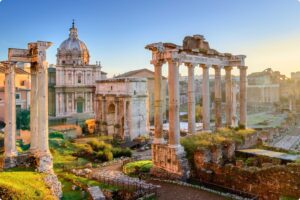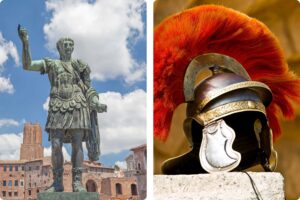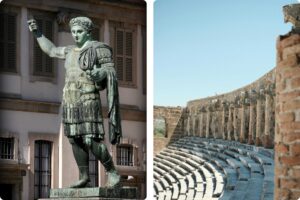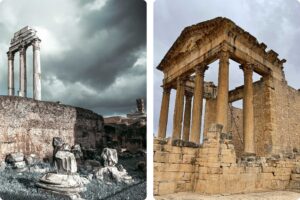Roma, famously known as the Eternal City, served as the thriving heart of the Roman Empire, which spanned vast territories—from Britain to North Africa and from Spain to the Middle East. At its height, Rome was the epicenter of power, politics, innovation, and culture, symbolizing the grandeur of one of history’s greatest civilizations.
The birth of an empire
The empire officially began in 27 BC when Augustus assumed the title of the first emperor, marking the end of the Roman Republic. Under his visionary leadership, Rome was transformed into a global superpower. With over a million inhabitants, it was the largest city in the ancient world and a shining beacon of influence and prestige.
Architectural marvels and engineering feats
The Roman Empire left an indelible mark on architecture and engineering. Iconic structures such as the Colosseum, the Basilica of Maxentius, and the Temple of Venus and Roma stand as testaments to Roman ingenuity. The Colosseum, in particular, symbolized the empire’s might and served as a grand amphitheater for gladiatorial games that captivated thousands.
Rome’s infrastructure was equally impressive. The construction of aqueducts, like the Aqua Claudia, ensured a continuous supply of fresh water to the city’s public baths, fountains, and households. Meanwhile, the meticulously designed Roman road network facilitated trade, military expeditions, and cultural exchange across the vast empire.
Politics and society in the Roman Empire
Rome was the political nerve center of the Roman Empire. The Forum Romanum served as the hub of governance, where senators debated, leaders made monumental speeches, and laws were enacted to shape the empire’s future.
Socially, the city was a mosaic of classes. At the top stood the emperor and wealthy patricians, while plebeians, slaves, and freedmen made up the majority. Despite stark inequalities, Rome offered diverse opportunities for social mobility through trade, military service, and the patronage of the elite.
Culture, entertainment, and religion
This empire fostered a rich cultural and recreational life. Theatres, such as the Theatre of Pompey, staged captivating plays and poetry readings, while the Circus Maximus thrilled audiences with exhilarating chariot races.
Religion permeated everyday life in Rome. Majestic temples were dedicated to gods like Jupiter, Minerva, and Juno, reflecting the deep spiritual fabric of Roman society. The Pax Romana, a period of relative peace and stability, nurtured advancements in art, literature, and science. Renowned writers like Virgil and Ovid emerged during this era, leaving behind literary masterpieces that are celebrated even today.
The fall of the Roman Empire
Despite its unmatched splendor, this empire eventually declined. Internal corruption, economic instability, and invasions by barbarian tribes weakened the once-mighty city. In 476 AD, the fall of the Western Roman Empire marked the end of an era.
Curious to explore the wonders of the Roman Empire? Embark on the SmartWalk Rome, a self-guided tour that takes you through the city’s ancient landmarks and hidden gems. Experience Rome as it was during its prime—the largest and most powerful city in the world. Walk in the footsteps of emperors, gladiators, and citizens, and immerse yourself in the history of the Eternal City.








